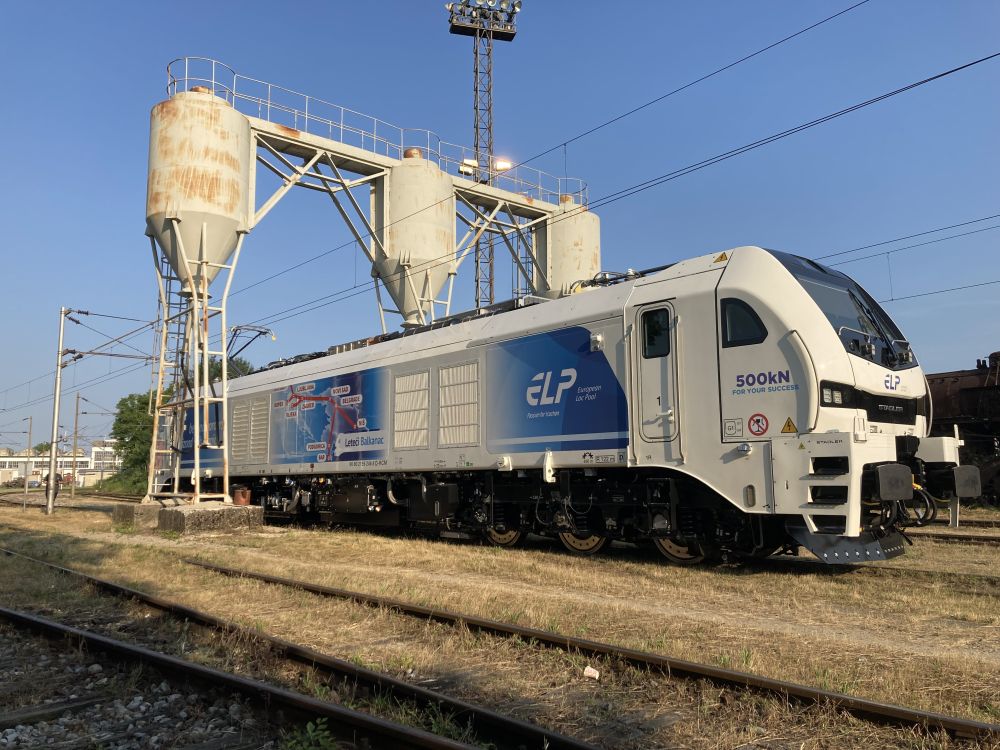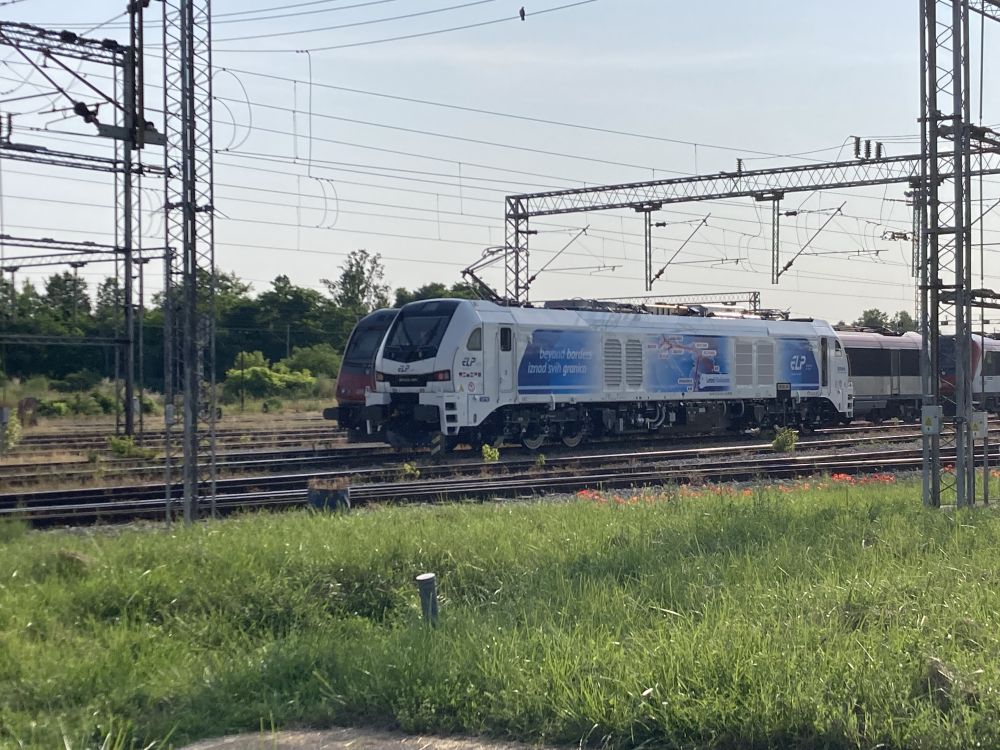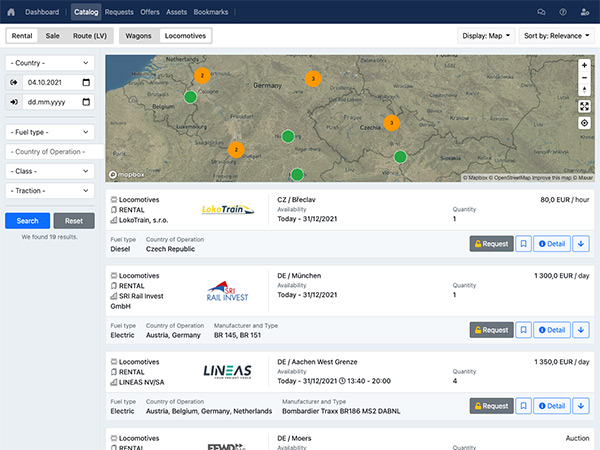You are introducing two new locomotive products, the Euro9000 and the EuroDual, to the rail freight market. What stage are they at?
Today, the Euro9000 is approved for operation in Germany, Austria and Switzerland. Additionally, we are awaiting the approvals for Belgium, the Netherlands and Italy.
We are still preparing Euro9000 for Eastern Europe to make it run on C4 lines as well, which is crucial. It is not easy, but we have significantly lower axle loads than other locomotives, like the Vectrons, and we see the potential there.
We have finalised the approval for Euro9000s to pass to Bratislava, Hegyeshalom and Břeclav border stations, and we are currently working on Poland and Slovenia as well.
The EuroDual is successfully operating in Germany, Austria, and Scandinavia. It has just been homologated in Serbia, and then Slovenian and Croatian homologations are expected by the end of the year. So, with the first Balkan round done, we will start the next round here to get the locomotive approved all the way to the Turkish border.
What made European Loc Pool decide to go to this region?
The catenary system, which is the same for 25 kV in Balkan, Greece, or Bulgaria - and the PZB safety system. So, we expand with EuroDuals towards southeast and Euro9000s towards Eastern Europe.
We have a lot of (potential) customers going to Istanbul, as Turkey is expected to be the next production alternative to SE Asia for Europe, so there will be a lot more movements on the Benelux-Germany-Turkey axis in the near future.

Does that mean you also want to lease locomotives on the Turkish market?
It is not expected that we will start leasing our locomotives in Turkey because of the exchange rate risk between the Lira and Euro and because of the current financial situation (inflation, interest rates etc..). But we are helping all current owners of EuroDuals in Turkey to set up some finance ability in Turkey. So, in the ideal case, our customers leasing EuroDual in Europe would get the cargo to the Turkish border and from there, Turkish owners of EuroDuals would take the train further to inland Turkey.
How about expansion westwards?
We have our eye on France, as some operators, such as Hupac, would welcome bypassing Germany, especially now with so much infrastructure work over there. So, with Euro9000, we would like to explore the option of bringing alternative routing from Italy and southern Europe to Belgian and Dutch ports. And then we may add Spain to have the other north-south corridor engaged on the European gauge. There is some interest in the Iberian gauge in Spain and Portugal, too.
How are you doing with approvals of the Euro9000 for operations in Europe?
We have approvals in Germany, Austria and most recently Switzerland. We expect Belgium and the Netherlands any moment in 2023, and Italy in mid-next year.
What are the next steps we can expect from European Loc Pool in the future?
Our vision is to positively disrupt the market and show rail freight can be done in a different way. I have been working in all logistics segments for over 42 years around the world, in Africa, Australia, Southeast Asia, the Americas and, of course, Europe. And I know, shamingly, nothing much “new” happened in Europe in the last 50-60 years. And it’s now time to change this. This was one of the prerequisites and the main strategy when we were setting up ELP to positively change things and to disrupt the current status quo.
How is that disruption materialised?
By creating a proper 6-axle hybrid locomotive. Until six years ago, a big part of the market said that we were mad and look now – we have proven we can do it. As a company, we are just over five years old and have 104 locomotives on order. We are 14 months ahead of our plans with orders and expect to place orders for 10 to 20 more locomotives before the end of this year. We have 30 Euro9000s on order, out of which 25 (and soon 28) have been signed on long-term full-service leases with eight customers in the Netherlands, Germany, Austria and Switzerland.
So, what is the next big target you have ahead of you?
Two hundred locomotives on order by the end of 2026. It was formerly 2028, but we think we can grow faster than that.
What is your strategy in ordering locomotives? Ordering in batches and then finding customers, or only ordering when you have lease agreements?
When we started, we knew how the market works. We had an agreement with our banks initially that we could order ten locomotives “at risk” (which means without lease agreements), but as we have built a great track-record and thus trust over the first years, we can order 20 “at risk locomotives” now. So, as soon as we get under 10 risk locomotives in the order pipeline, we order another batch of 10. While the locomotives are being manufactured, we have the time to sign lease agreements. From my experience, we know you need this stable flow and buffer. If you wait until you have a lease signed, you have to wait at least another two years for your locomotive(s), but this is too long for most of our customers. More than 80% of our customers are private operators who order one, two or maybe three locomotives at a time, but the manufacturer needs at least ten to set up a proper production line. So, this is our way to pro-act and succeed in the market in a win-win situation for everyone.
Have you encountered a change in locomotive delivery times over the past?
Significantly. We formerly had ten months ex-works delivery time. That has, during Covid, and later as a consequence of the situation in the Ukraine extended to 22 months, but it is slowly getting more stabilised, and we are below 18 months with Stadler now. But compared to other manufacturers, delivery times are up to three years for new orders, this is one of our strengths, too.
You came up with leasing for many small customers in Germany. What was your approach here?
Smaller companies only sometimes have all credit options or the service capacities available. With our full-service lease contracts, we make it easily accessible for all market players. To mitigate the risks, we use our assets as our security. If something goes wrong, we take back our locomotive(s), which is/are making the money for our customers. Over the last five years, we only experienced three times that customers got into cashflow issues, we however have always been able to find suitable solutions for both our customers and ourselves. Besides, our customers pay us a security deposit as well, so if something goes wrong, we can pay for the damages resulting from the early termination of the lease contract. I have experience with these kinds of situations in the past, and it works in Africa. If it works there, it works in Europe too.
Our strong argument for choosing our locomotive – six axles. In the entire world, rail freight runs on six axles, but in Europe, it does not.
In North America, four-axle locomotives disappeared a long time ago. Locomotives became stronger, bigger and longer too. What was hindering Europe? Conservatism?
And arrogance. I was part of the first lease of a Class 66 locomotive in Europe in 2004. But at that time, no manufacturer had an appetite for producing six-axle electrics – and they still do not have it now. I was fortunate to join forces with Peter Spuhler, Chairman of the Board of Stadler Rail AG, who wanted to speed up the sales of hybrid locomotives. The idea was perfectioned by Stadler, and the Valencia plant is now busy producing them. The fact that our leasing product enables customers to test the locomotives before actually using them led to some purchase orders from German customers, too.
Do you see the future of rail freight in Europe on six axles?
In certain segments, yes. People used to say there was no chance for six-axle corridor locomotives. But we disagree with that. And with the diesel function of the EuroDual and Euro9000 we can go from terminal to terminal, without uncoupling the trainset. Our customers can now offer integrated door-to-door solutions with the heaviest of trains and by using the remote control to do this with a single driver. We are taking efficiency and productivity to the next level!

This also brings us to the question of the former national operators and private companies. Where do you see your future customers?
We have customers among incumbents, such as DB Cargo or Cargonet and Green Cargo, in the past. But we expect much more from the private sector. And we are also targeting producers/shippers, the customers of our customers. Shippers are getting deeper into the logistics chain, and they see the benefit of doing things efficiently. It does not matter if it is a shipping company or a big chemical producer. The end customers look for efficient and green ways of moving the goods they need to move.
How do you handle the maintenance of your fleet?
We have a frame agreement with the manufacturer, which brings a lot of advantages from warranty to spare parts point of view. We have agreed a minimum 95% availability guarantee (this will even be higher with lower mileages) , which is tough, but achievable. With our Stadler locomotives we have achieved an overall 96.8% availability this year. This means our locomotives have been available available 353 on average days per year, that’s the way to make money in the rail freight segment.
Other manufacturers call their locomotives for maintenance intervals at 25 or 35,000 kilometres, we are currently at 50,000 and the next aim is to get to 100,000 km intervals. Many people may shake heads now, but they never leave their comfort zone until you challenge them, so we do.
How many people work for ELP?
For the first two years, I did it alone. Now, there is a team of 11 people. We expect to grow to 13 by the end of the year. A leasing company shouldn’t need more than a maximum of 20 people. As long as you outsource capacity-intensive activities like maintenance, it is all you need.
Diesel is increasingly perceived as the dirty word, no matter how efficient the Stage V locomotive engines are. How do you look at that from the engines in your hybrid locomotives?
We are fully convinced of the need to replace fossil fuels, although recent developments like the use of HVO-Diesel are creating new opportunities for a more sustainable operation on non-electrified lines. But at the beginning of this year, we started with the project to replace the diesel engines in our Euro9000 locomotives, and we will soon be able to offer this opportunity. We had to wait for the economy of scale to make batteries better and less expensive, but the time is coming now. Five years ago, if you’d put a locomotive on a battery package, it would be at least one million euros more expensive and with less performance. So, we are working on implementing that on Euro9000’s now. Not for EuroDuals, as putting a battery package equalling a 2.8MW diesel engine would make it an economically unsellable product. The Euro9000 has two times 950 kW, and now we are working with Stadler and battery providers to make this change possible.

What is your view on hydrogen?
Hydrogen is not a real solution for the European railway segment, certainly not for heavy haul freight operations. It may be a solution for big countries such as the US, China, Russia, or Australia, where most network parts are not electrified, and infrastructure requirements are less restrictive than in Europe. But if I were a train manufacturer, I would bet my money on battery technology.
What is the biggest obstacle in implementing your disruptive innovations to the market?
Bureaucracy. And the fourth railway package is making it worse. If we now have homologation in Austria, it will take us two years to get to the border stations. Improvements in the infra-access conditions have to be discussed with the infrastructure managers, who are not inclined to think in the interest of the operators but only the impact on their networks, imposing all kinds of restrictions and blocking innovations. And what annoys us is that we have to take a lot of risks and spend money to change things for the better. Everything in the railway is complicated, and it is not getting better or faster, but vice-versa. That is why road took so much share in transportation. We have to address this, too. We need to get lean and digital. You still have to print three copies of everything, and if you want to have a locomotive homologated in 10 countries, you have to do it all in 10 languages. I was part of a working group back in the '90s when we proposed a single language, but Germany and France, the big countries, opposed and blocked it. Just like the unions in Germany and France blocked the use of a single language for train drivers, who cross borders more and more frequently.
But, there seem to be more obstacles in European railways, such as infrastructure.
Yes, it is a shame to see what happened in underinvestment in rail infrastructure in Germany, France or the Netherlands. There are now big closures and big bypasses ahead. With it comes a big demand for hybrid locomotives that could take alternative routes in Germany. They say they will finish the works by 2033-35, but we expect it to last at least until 2050.
So our early customers now reap the benefits of their decision to go with EuroDual. They got the locomotive at least 10-15% cheaper than now – after Covid and with impacts of war, energy and inflation issues. So you never know what is ahead, but if you adopt innovation early on, you eventually win in the long game. And doing business in railways is about the long game.
Thank you for the interview.
Stay tuned for part 2 of Railmarket News’ interview with Willem Goosen, revealing even more disruptive innovations planned for European railways.

